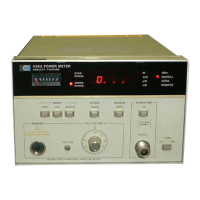Operation
3-12.
HEWLETT-PACKARD INTERFACE
BUS
REMOTE OPERATION
NOTE
For a quick and easy programming guide
see
Figure 3-8; for detailed information
study paragraphs 3-12 through 3-61.
3-13. Hewlett-Packard Interface Bus (HP-IB)
Option 022
adds
remote
programming
and
digital
output
capability
to
the Power Meter.
For
further
information
about
the
HP-IB, refer to IEEE
Stand-
ard
488
and
the
Hewlett-Packard Catalog. Power
Meter compatibility, programming, and
data
for-
mat
is
described
in
detail
in
the
paragraphs which
follow.
3-14.
Compatibility
3-15. The
Power
Meter controls
that
can
be pro-
grammed via
the
Hewlett-Packard Interface Bus
are
the
MODE
and
SENSOR ZERO
switches. The
controls
not
programmable are
the
POWER
REF
and LINE switches. The CAL FACTOR
%
switch
can be enabled
and
disabled via the interface bus
but, when enabled,
the
calibration factor entered
at the front-panel
of
the
Power Meter is used.
3-16. In addition, specific ranges can be set and
various triggering options are available
to
the
pro-
grammer. This will be described in detail later.
3-1
7. The programming capability
of
the
Power
Meter will be described in terms
of
the
twelve bus
messages found in Table 3-1.
3-18.
Data
Messages
3-19. The Power
Meter communicates
on
the
bus
primarily through
data
messages.
It
receives
data
messages
that
tell
it
what
range
to
use,
what
mode
to use, whether
or
not
cal factor should be en-
abled, and
what
the
measurement rate should be.
It
sends
data
messages
that
tell the measurement
value,
the
mode
and
range
the
value was
taken
at,
and what
the
instrument's
status (see Table 3-4)
was when it
took
the
measurement.
3-20.
Table 3-2 outlines
the
key elements involved
in making a measurement. Indeed the Power Meter
can be programmed
to
make
measurements via
the
HP-IB
by
following only
the
sequence suggested in
the table, and briefly referring
to
Tables 3-3, 3-4,
(input and
output
data),
and
Fig. 3-8. However,
to
take advantage
of
the
programming flexibility
built
into
the
Power Meter
and
minimize
the
time
it
3-14
Model
436A
takes
to
make a valid measurement,
study
the
rest
of
the
information in this section.
3-21.
Receiving
Data
Messages
3-22. The Power Meter is configured
to
listen
(re-
ceive data) when
the
controller places
the
interface
bus in the command mode (ATN
and
REN lines
low;
IFC
line high) and
outputs
listen
address"-"
(minus sign). The Power Meter
then
remains
con-
figured to listen (accept programming inputs when
the interface bus is in the
data
mode) until
it
is
un-
addressed
by
the
controller. To unaddress the
Power Meter,
the
controller can either send
the
Abort
Message (set the IFC line low)
or
send
the
Local Message (set the
REN
line high),
or
it
can
place the interface bus in
the
command
mode
and
generate a universal unlisten command.
3-23.
Data
Input Format.
The Power Meter does
not
require any particular
data
input
format.
It
is
capable
of
responding
to
each
of
the
programming
codes listed in Table 3-3
on
an individual basis.
Because
it
responds
to
these codes in
the
order
it
receives
them,
we recommend
that
the
code for
measurement rate be sent last.
•
3-24.
Program
Codes.
Table 3-3 lists
the
program
r.
•.
codes
that
the
Power Meter responds
to
and
the
functions
that
they enable.
In
the
listen mode, the
Power Meter can handshake
in
0.5
µs.
The time re-
quired for
the
Power Meter
to
respond
to
the
pro-
gramming command, however, depends
on
where
the Power Meter is in
the
operating program (see
Figure 3-6). The overall
worst
case time for Power
Meter response
to
a programming
command
is
2.5 seconds,
the
minimum response time is approx-
imately
100
microseconds.
NOTE
In addition to the program codes listed
in Table
3-3,
Power Meter operation will
be affected by
all
other
program codes
shown
in
columns
2,
3, 4, and 5
of
Table
2-2,
except
(SP!"#$%&*).
Thus
care
should
be
taken to
"address
the Power
Meter to unlisten before sending these
programming commands to other
instru-
ments
on
the interface bus.
3-25.
Programming
the
Range.
Remote
range
pro-
gramming
is
slightly different
than
Local range
,'.
selection.
For
Local operation
the
Power Meter
auto-ranges.
For
Remote operation,
the
program
codes have provision for direct selection
of
the
de-

